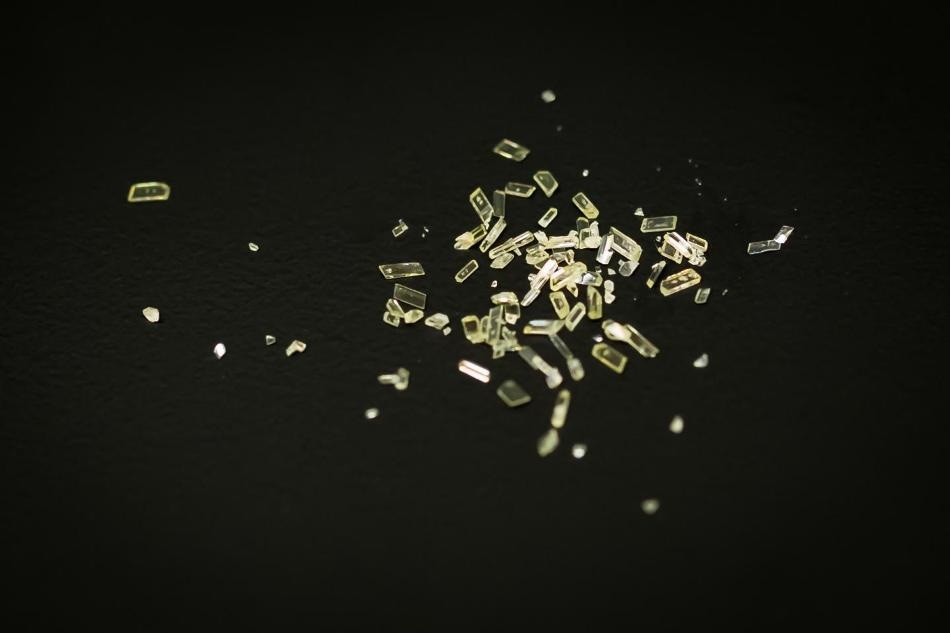Jan 10 2017
 When an aqueous solution of a simple guanidine compound was open to air, beautiful prism-like crystals started to form as the material absorbed carbon dioxide. (CREDIT - Oak Ridge National Laboratory/Genevieve Martin)
When an aqueous solution of a simple guanidine compound was open to air, beautiful prism-like crystals started to form as the material absorbed carbon dioxide. (CREDIT - Oak Ridge National Laboratory/Genevieve Martin)
A team of researchers at the Department of Energy’s Oak Ridge National Laboratory have discovered a simple, reliable method to capture carbon dioxide (CO2) directly from ambient air, providing a new alternative for carbon capture and storage strategies to tackle global warming.
Initially, the ORNL team was analyzing techniques to eliminate environmental contaminants such as chromate, sulfate, or phosphate from water. In order to eliminate those negatively charged ions, they synthesized a simple compound called guanidine with the capacity to adhere strongly to the contaminants and develop insoluble crystals that can be separated from water in an easy manner.
During the process, they discovered a technique to trap and release CO2 that requires minimum energy and chemical input. Their results have been published in the journal Angewandte Chemie International Edition.
When we left an aqueous solution of the guanidine open to air, beautiful prism-like crystals started to form. After analyzing their structure by X-ray diffraction, we were surprised to find the crystals contained carbonate, which forms when carbon dioxide from air reacts with water.
Radu Custelcean, ORNL
Several years of research has resulted in the development of carbon capture and long-term storage strategies to reduce the output or eliminate emissions of CO2 of power plants. CO2, a heat-trapping greenhouse gas, adds to a rise in temperatures worldwide. Carbon capture and storage strategies consists of an integrated system of technologies that gathers CO2 from the point of emission or directly from the air, then conveys and stores it at pre-determined locations.
A less conventional technique that absorbs CO2 previously present in the atmosphere, called direct air capture, is the focal point of ORNL’s research illustrated in this paper, although it could also be used at the point where CO2 is released.
After CO2 is captured, it has to be released from the compound so the gas can be conveyed regularly via a pipeline, and injected deep underground for storage. Customary direct air capture materials have to be heated up to 900 °C to discharge the gas -- a process that frequently discharges more CO2 than primarily removed. The guanidine material developed by ORNL offers a less energy-intensive option.
Through our process, we were able to release the bound carbon dioxide by heating the crystals at 80-120 degrees Celsius, which is relatively mild when compared with current methods.
Radu Custelcean, ORNL
The crystals reverted to the original guanidine material upon heating. The recovered compound was recycled via three successive carbon capture and release cycles.
While the direct air capture technique is gaining traction, according to Custelcean, the process still requires more development and has to be aggressively implemented to be effective in tackling global warming. Furthermore, they have to get a better understanding of the guanidine material and how it could be advantageous to existing and future carbon capture and storage applications.
The research team is currently analyzing the crystalline structure and properties of the material together with the unique neutron scattering capabilities at ORNL’s Spallation Neutron Source (SNS), a DOE Office of Science User Facility. The researchers are studying carbonate binding in the crystals as they hope to improve their understanding of the molecular mechanism of CO2 capture and release and enable design the next generation of sorbents.
The team is also planning to examine the use of solar energy as a sustainable heat source in order to release the bound CO2 from the crystals.
The research titled, “CO2 Capture from Ambient Air by Crystallization with a Guanidine Sorbent,” included Charles Seipp of ORNL and the University of Texas at Austin; Neil Williams of ORNL and the University of Tennessee; and ORNL’s Michelle Kidder and Radu Custelcean.
DOE’s Office of Science funded the research.